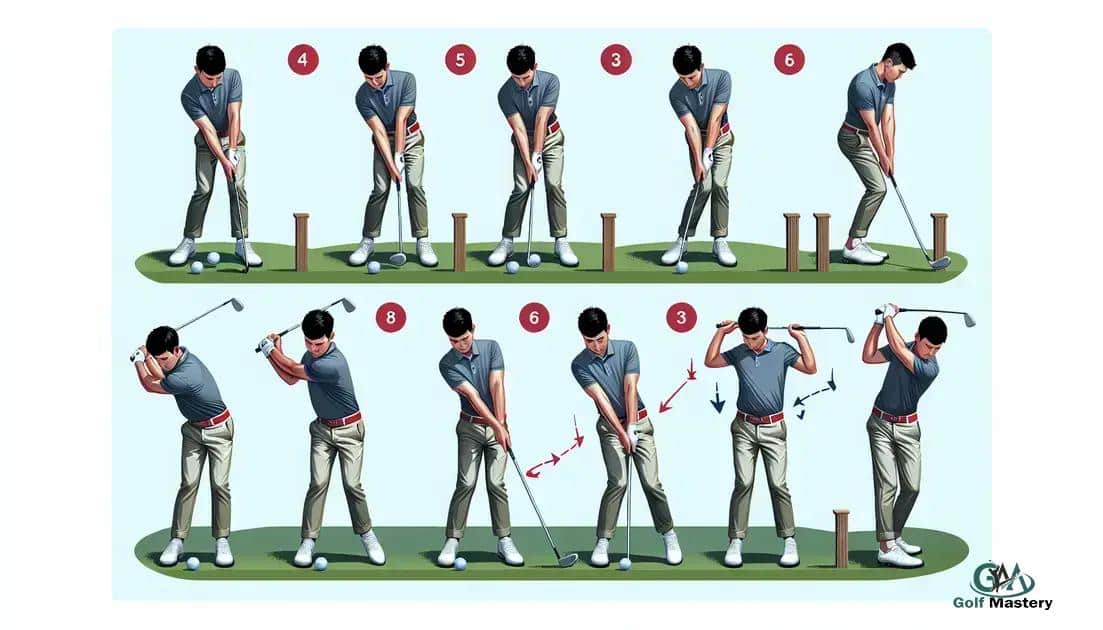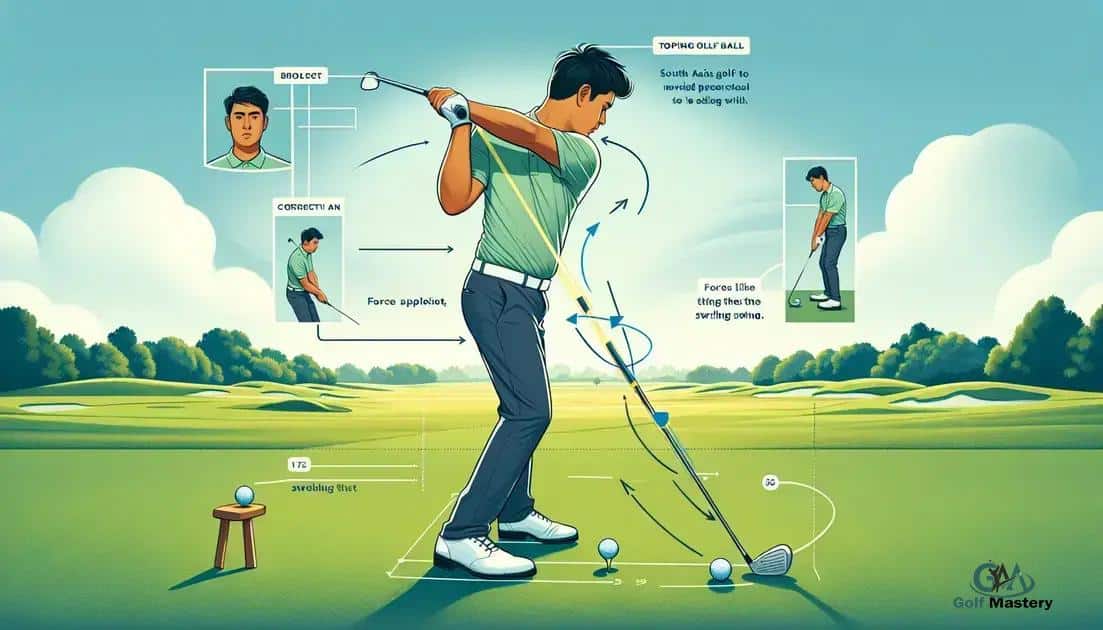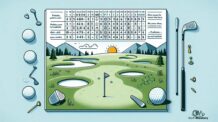How to stop topping the golf ball by improving your swing technique and practice routine. Learn tips and drills to enhance your game today.
To stop topping the golf ball, focus on proper grip adjustments, maintaining correct posture and alignment, and eliminating common mistakes. Practice specific drills to improve your swing mechanics and enhance your overall game performance.
Are you struggling with how to stop topping the golf ball? This common issue can frustrate golfers of all skill levels. By focusing on your grip, posture, and swing technique, you can improve your performance on the course. In this article, we will explore essential tips and effective drills to help you eliminate topping and hit the ball with confidence.
Understanding Why You Top the Ball
Many golfers often find themselves asking, “Why do I top the ball?” Understanding the causes of topping is the first step to correcting this frustrating issue. Topping occurs when the club strikes the top half of the ball, causing it to lift ineffectively into the air or roll along the ground. Here, we will dive into the reasons behind this common mistake, focusing on two main areas: swing mechanics and golfer mindset.
Common Reasons for Topping the Ball
The most prevalent cause of topping the ball is poor swing mechanics. When golfers swing, they may consciously or unconsciously lift their heads too early. This premature lifting creates a misalignment with the ball, leading to inconsistent contact. Similarly, if the downswing is too steep, it can result in hitting the top half of the ball instead of making solid contact at the equator.
The Importance of Balance
Another crucial factor is balance. If a golfer loses their balance during the swing, it often results in an awkward contact with the ball. Maintaining a stable posture throughout the swing allows you to strike the ball effectively. Proper weight distribution is vital—your weight should shift smoothly from your back foot to your front foot during your swing.
Mindset and Approach
Your mental approach also plays a significant role. Becoming overly anxious about making solid contact can lead to one’s natural instincts being overridden, resulting in topping. A focused, relaxed mindset encourages a smooth swing, allowing you to make better contact with the ball.
By recognizing the various reasons why you top the ball, you can begin to make adjustments in your grip and stance. Addressing these issues will empower you to progress on your journey toward mastering your golf swing.
Essential Grip Adjustments
Adjusting your grip can play a critical role in stopping you from topping the ball. A proper grip helps maintain control of the club throughout your swing. Here are some essential grip adjustments that can significantly improve your performance.
Identify Your Grip Type
There are several types of grips: the interlocking grip, the overlapping grip, and the ten-finger grip. Each has its advantages. The interlocking grip is common among players with smaller hands. The overlapping grip provides a more stable connection for many golfers. The ten-finger grip is often favored by beginners because it offers a strong grip on the club.
Checking Grip Pressure
Another important aspect is the pressure you apply to the grip. Too much pressure can cause tension in your swing, leading to topped shots. Aim for a grip pressure that feels firm but relaxed. You should be able to wiggle your fingers slightly while holding the club, which indicates you have the right amount of pressure.
Positioning the Hands
The position of your hands on the club is crucial. Make sure your thumbs are pointing straight down or slightly right (for right-handed players) on the club. The lead hand (left hand for right-handed players) should sit comfortably on top, while the trail hand (right hand for right-handed players) should sit beneath.
Aligning the Hands
Also, check the alignment of your hands. The V formed by your thumb and index finger should point towards your right shoulder (for right-handed players). This positioning ensures that your hands lead the clubhead during the swing, minimizing the chances of topping the ball.
By making these essential grip adjustments, you will start to see improvements in your swing consistency. A proper grip gives you better control, leading to better contact with the ball and fewer topped shots.
Posture and Alignment for Success
Proper posture and alignment are key factors in improving your golf game and reducing the chances of topping the ball. When you set up correctly, you can create a stable base that allows for a smooth swing. Here are some essential tips on posture and alignment.
Achieving Proper Posture
Your posture should be athletic and balanced. Start with your feet shoulder-width apart, allowing for a firm foundation. Bend slightly at the hips and keep your back straight. Your knees should be slightly flexed to maintain balance. This athletic stance helps you stay centered throughout your swing.
Aligning Your Body
Next, align your body to your target line. Your feet, hips, and shoulders should all be parallel to the target. Use your club as a guide by laying it down on the ground, pointing towards your target. Then position your feet and body parallel to that line. This helps ensure you are aiming correctly and discourages topping.
The Role of Weight Distribution
Weight distribution is also essential. At address, your weight should be evenly distributed between your feet. As you prepare to swing, focus on shifting your weight smoothly from your back foot to your front foot. This motion helps generate power and stability, leading to better contact with the ball.
Club Positioning
Your club should be positioned directly in front of you, with the ball located in line with your left foot (for right-handed players). This positioning allows for a natural downward strike on the ball, reducing the chances of topping. Make sure that your arms hang relaxed and slightly bent from your shoulders.
By mastering proper posture and alignment, you set yourself up for success on every shot. When your body is positioned correctly, you increase your chances of making solid contact with the ball, which helps you stop topping it.
Practice Drills to Avoid Topping
Practicing specific drills can greatly help you avoid topping the golf ball. These exercises focus on swing mechanics and ball contact, improving your overall performance. Here are some effective drills you can incorporate into your practice routine.
The Footwork Drill
Start by setting up as if you were going to hit a shot. However, take your left foot (right for left-handed golfers) and move it back about a foot. This will force you to make better contact with the ball without topping it. Focus on keeping your weight on your back foot during the back swing and transferring it smoothly to your front foot on the downswing. Repeat this drill several times to build muscle memory.
The Tee Drill
For this drill, place a tee in the ground without a ball on it. Spend a few practice swings focusing on hitting the tee with the clubhead instead of the ball. This encourages you to strike downward, helping to improve your contact point and reduce the chances of topping the shot.
The One-Handed Drill
This drill involves practicing your swing with one hand at a time. Start with your lead hand (left hand for right-handed players) and take swings focusing solely on that hand’s movement and grip. After a few practice swings, switch to your trailing hand (right hand for right-handed players). This drill helps you understand your swing mechanics better and develop more control during your full swing.
The Slow Motion Swing Drill
Performing slow-motion swings can enhance your feel for the proper mechanics. Take your club back slowly and pause at the top of your backswing before coming down to make contact. This will help you focus on your posture and alignment throughout the swing. It also minimizes the likelihood of rushing the swing, which often leads to topping.
Incorporating these practice drills into your routine can help you become more aware of your swing mechanics. Improving your swing will lead to better contact and reduced topping over time.
Common Mistakes to Eliminate
Eliminating common mistakes from your golf game can significantly improve your ability to stop topping the ball. Here are some prevalent errors to watch out for and correct.
1. Lifting Your Head Too Early
One of the most common mistakes is lifting your head before the ball is hit. This can cause you to lose sight of the ball and disrupt your swing. Focus on keeping your head down until after you make contact to ensure proper timing and a better strike.
2. Using Incorrect Grip Pressure
Applying too much or too little pressure on the grip can lead to inconsistent shots. As mentioned before, a relaxed grip is ideal. Focus on maintaining firm yet light pressure to enhance control without creating tension in your hands or arms.
3. Poor Posture and Alignment
As discussed in the previous sections, incorrect posture and alignment can drastically affect your swing. Make sure to stand correctly with your feet shoulder-width apart and align your body parallel to your target line. Ignoring these fundamentals can lead to topped shots.
4. Rushing the Swing
Many golfers rush their swings, leading to sloppy mechanics. Take your time to properly set up and execute each swing. Practicing slow-motion swings can help you build the right pace and rhythm.
5. Ignoring Follow-Through
After making contact with the ball, many golfers forget about the follow-through. A proper follow-through ensures that the club continues on its correct path and can help prevent topping. Practice following through your swing fully to improve your overall mechanics.
By eliminating these common mistakes, you’ll set a solid foundation for a consistent and effective golf swing, reducing the chances of topping the ball.
Master Your Swing and Eliminate Topping
Stopping topping the golf ball is achievable with the right understanding and practice. By exploring the causes, making essential grip adjustments, maintaining the correct posture and alignment, and practicing targeted drills, you can enhance your swing mechanics.
Avoiding common mistakes is also crucial for your improvement. By being conscious of your head position, grip pressure, and follow-through, you prepare yourself to hit the ball consistently.
With dedication and consistent practice, you can master your swing, build confidence, and ultimately enjoy a more successful golfing experience. Commit to these techniques and watch your golf game improve dramatically!
FAQ – Frequently Asked Questions about Stopping Topping the Golf Ball
What does it mean to top the golf ball?
Topping the golf ball occurs when the club strikes the upper half of the ball, causing it to lift poorly into the air or roll along the ground.
How can grip adjustments help reduce topping?
Proper grip adjustments ensure better control over the club, helping to create a consistent swing path and making solid contact with the ball.
What drills can I practice to avoid topping?
Useful drills include the footwork drill, tee drill, one-handed drill, and slow-motion swing drill, all focusing on improving swing mechanics.
What posture should I maintain when hitting the ball?
Stand with feet shoulder-width apart, bend slightly at the hips, keep your back straight, and ensure your weight is evenly distributed for better stability.
Which common mistakes should I eliminate to avoid topping?
Common mistakes include lifting your head too early, using incorrect grip pressure, poor posture, rushing the swing, and ignoring follow-through.
How can I improve my follow-through?
Focus on allowing the club to continue its motion after hitting the ball, ensuring a complete and balanced follow-through helps with consistency.






Leave a Reply